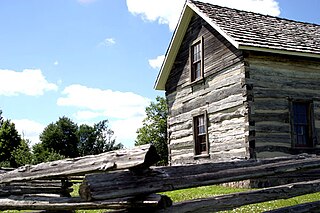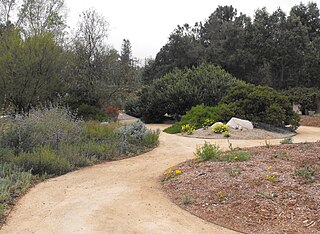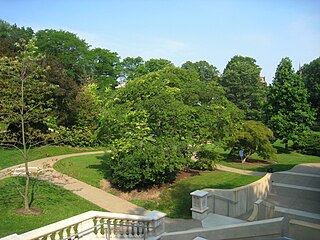Related Research Articles

An arboretum in a general sense is a botanical collection composed exclusively of trees of a variety of species. Originally mostly created as a section in a larger garden or park for specimens of mostly non-local species, many modern arboreta are in botanical gardens as living collections of woody plants and is intended at least in part for scientific study.

The United States National Arboretum is an arboretum in northeast Washington, D.C., operated by the United States Department of Agriculture's Agricultural Research Service. It was established in 1927 by an act of Congress after a campaign by USDA Chief Botanist Frederick Vernon Coville.

The H. H. Hunnewell estate in Wellesley, Massachusetts was the country home of H. H. Hunnewell (1810–1902), containing over 500 species of woody plants in 53 families. The estate remains in the family, and includes the first (1854) topiary garden in the United States, featuring intricate geometrically clipped native Eastern white pine and Eastern arborvitae. A collection of specialty greenhouses feature over 1,000 plant species. The estate has been cared for by six generations of the Hunnewell family.

The Connecticut College Arboretum is a 300 ha arboretum and botanical gardens, founded in 1931, and located on the campus of Connecticut College and in the towns of New London and Waterford, Connecticut, United States.

The Arboretum at Gustavus Adolphus College, also known as TheArboretum at Gustavus or colloquially as The Arb, is on the campus of Gustavus Adolphus College in Saint Peter, Minnesota, United States. It contains a number of botanical gardens and a 125 acre arboretum with its first trees planted as small seedlings in 1973 on agricultural land. The arboretum was formerly named for Carl Linnaeus, a Swedish botanist, from 1988 to 2021.
Hidden Lake Gardens colloquially known as Hidden Lake 755 acres (3.06 km2), is a botanical garden and an arboretum operated by Michigan State University situated in the Irish Hills of southeast Michigan. The Gardens are known for their large collection of native and nonnative trees, shrubs and flowers. HLG was given to Michigan State University by Harry Fee in 1945. Today it is visited by nearly 45,000 people annually. Hidden Lake Gardens mission is to "preserve and enhance the natural beauty of the gardens and to display plants for the inspiration and education of the public".

The California Botanic Garden is a botanical garden in Claremont, California, in the United States, just south of the San Gabriel foothills. The garden, at 86 acres (35 ha), is the largest botanic garden in the state dedicated to California native plants. It contains some 70,000 native Californian plants, representing 2,000 native species, hybrids and cultivars. The seed bank has embryos for the thousands of rare plants.
The South Arkansas Arboretum is an arboretum and botanical garden owned by the local school system but operated as Arkansas's 50th state park by the South Arkansas Community College. It is located next to the former El Dorado High School in El Dorado, Arkansas, USA and open daily except for holidays.

Penn State Erie, The Behrend College, known as Penn State Behrend, is a four-year and graduate college of Penn State University and is located just outside Erie, Pennsylvania. It is among the largest of Penn State's commonwealth campuses, with about 4,400 students enrolled in Behrend programs on campus and online. The college offers more than 40 undergraduate majors in four academic schools: The Sam and Irene Black School of Business, the School of Engineering, the School of Humanities and Social Sciences, and the School of Science, which includes the Nursing Program. Behrend also offers five master's degrees, as well as a diverse range of continuing education trainings through its Community and Workforce Programs.

Bailey Arboretum is a 42-acre (17 ha) arboretum located in Lattingtown, New York, a small village on the North Shore of Long Island. It opened to the public on Aug. 5, 1969 after being donated to Nassau County in 1968 by the heirs of Mr. and Mrs. Frank Bailey. Through an agreement with the Village of Lattingtown, admission to the arboretum was limited to 200 people at any one time.

The University of Illinois Arboretum is a new arboretum, with gardens, currently under construction on the University of Illinois Urbana-Champaign campus. It is located at the intersection of Florida and Lincoln Avenue, Urbana, Illinois, and open daily without charge.

The University of Michigan Matthaei Botanical Gardens includes botanical gardens, natural areas with trails, and several research-quality habitats and is part of the organization Matthaei Botanical Gardens and Nichols Arboretum. The conservatory is popular year round. The public entrance is at 1800 North Dixboro Road in Ann Arbor, Michigan. The grounds are open every day, but trails are not maintained in the winter. The conservatory, garden store, and lobby are open 7 days a week: Mon., Tues., and Thurs. - Sun., 10:00 am–4:30 pm; Wednesdays 10 am-8 pm. The building complex is only closed on three holidays a year. The institution's main web site with updated information is Matthaei Botanical Gardens and Nichols Arboretum.

Nichols Arboretum, locally known as the Arb, is an arboretum operated by the Matthaei Botanical Gardens and Nichols Arboretum (MBGNA) at the University of Michigan. Located on the eastern edge of its Central Campus at 1610 Washington Heights in Ann Arbor, Michigan, the Arboretum is a mosaic of University and City properties operated as one unit. The arboretum is open daily from sunrise to sunset with no charge for admission. The Huron River separates a northern section of the arboretum's floodplain woods; the railroad marks the northern border.
The Hofstra University Arboretum is an arboretum located across the Hofstra University campus, in Hempstead, New York. Hofstra's campus is a member of the American Public Gardens Association, and is one of 430 arboreta in the United States.

The Cornell Botanic Gardens is a botanical garden located adjacent to the Cornell University campus in Ithaca, New York. The Botanic Gardens proper consist of 25 acres (10 ha) of botanical gardens and 150 acres (61 ha) of the F. R. Newman Arboretum. The greater Botanic Gardens includes 40 different nature areas around Cornell and Ithaca, covering 4,300 acres (1,700 ha).

The Haverford College Arboretum is an arboretum comprising the entire campus of Haverford College, in Haverford, Pennsylvania. It is open daily, dawn to dusk, without charge.

The Dominion Arboretum is an arboretum part of the Central Experimental Farm of Agriculture and Agri-Food Canada in Ottawa, Ontario, Canada. Originally begun in 1889, the Arboretum covers about 26 hectares of rolling land between Prince of Wales Drive, Dow's Lake and the Rideau Canal. Carleton University is located at the opposite side of the Canal. At a latitude of 45°, it can experience extremely hot and humid summers and extremely cold winters.

The Arboretum at Penn State, which contains the H.O. Smith Botanic Gardens, is a new arboretum being created by The Pennsylvania State University adjacent to its University Park campus in State College, Pennsylvania. It will become Penn State's second arboretum, joining the Arboretum at Penn State Behrend, which was created in 2003.

Chatham University Arboretum is an arboretum located on the campus of Chatham University at Woodland Road, Pittsburgh, Pennsylvania, United States. It is open to the public daily without charge.
The Sam and Irene Black School of Business is the business school of Penn State Behrend, a four-year college of Penn State University. The Black School was founded in 1998 when the Black family donated a gift of $20 million to the college. The school is located in the Jack Burke Research and Economic Development Center on the Behrend campus.